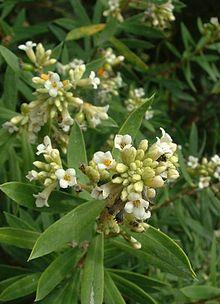Daphne gnidium
| Flax-leaved daphne | |
|---|---|

| |

| |
| Unripe fruits (drupes) | |
| Scientific classification | |
| Kingdom: | Plantae |
| Clade: | Tracheophytes |
| Clade: | Angiosperms |
| Clade: | Eudicots |
| Clade: | Rosids |
| Order: | Malvales |
| Family: | Thymelaeaceae |
| Genus: | Daphne |
| Species: | D. gnidium
|
| Binomial name | |
| Daphne gnidium | |
Daphne gnidium (commonly known as the flax-leaved daphne) is a poisonous evergreen shrub from the Mediterranean region with narrow, dense dark-green foliage and white fragrant flowers.
Description
[edit]Daphne gnidium is characterized by upright branches that grow 1.5 to 2 m (4 ft 11 in to 6 ft 7 in) tall. The dense lanceolate leaves are dark green with sticky undersides. It bears white fragrant flowers in late spring or early summer. The fruits are drupes and are round and red, about 8 mm (0.31 in) in diameter. They are produced during autumn.[2] [3]
Habitat
[edit]Daphne gnidium grows well in sandy loam. They are commonly found in fields, woodlands, garrigues, and hillsides. They are native to the areas surrounding the Mediterranean Sea (Southern Europe, Northern Africa, and the Middle East).
Toxicity
[edit]Daphne gnidium contains the toxins mezerein and daphnetoxin. All parts of the plant are considered highly poisonous. Skin contact with the sap can cause dermatitis[4]
Chance of death is small yet possible within 6 hours after direct consumption. At least severe anabolic and indigestive reactions are expected (which may also trigger lethal allergic reactions).[citation needed]
References
[edit]- ^ "Daphne gnidium". The Plant List. Retrieved 2017-11-19.
- ^ "Daphne gnidium (Flax-leaved daphne)". shootgardening.co.uk. Retrieved January 22, 2011.[permanent dead link]
- ^ "'Daphne gnidium L. (Daphne)". botanical-online.com. Retrieved January 22, 2011.
- ^ "Daphne gnidium L". botanical-online.com/. Retrieved January 22, 2011.
